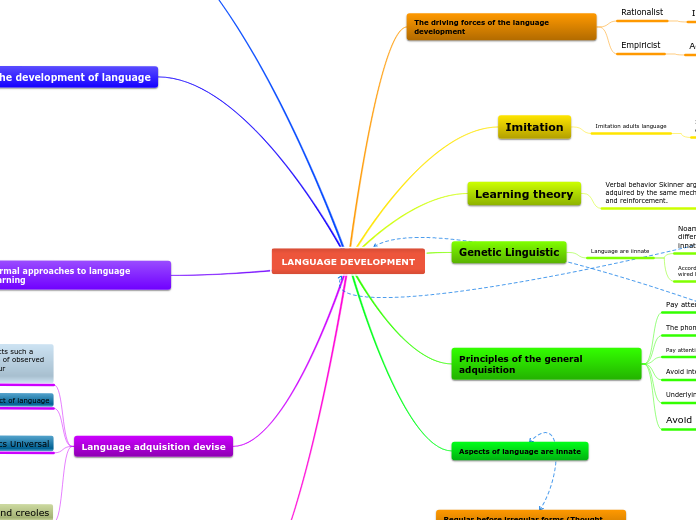LANGUAGE DEVELOPMENT
The driving forces of the language development
Rationalist
Innate
Originated from Plato and Descartes
Empiricist
Acquired
Through experience
Imitation
Imitation adults language
Imitation plays in language development. The ability to copy and learn
Learning theory
Verbal behavior Skinner argued that language was adquired by the same mechanims of conditioning and reinforcement.
Genetic Linguistic
Language are iinnate
Noam Chomsky had come up with an entirely different and surprising explanation called innateness hypothesis.
According to Chomsky humans are born with innately hard wired language capabilities.
Principles of the general adquisition
Pay attention to the ends of the words
The phonologica form of words can be modified
Pay attention to the order of morphemes of words
Avoid interruptions of rearrangement of units
Underlying semantic relation
Avoid exceptions
Aspects of language are innate
The role of child direct speech
Children hear degenarative input "It is fulls of slips of the tongue
Motherase: Special way of talking to children "Babytalk"
The development of language
Vegetative sounds (0- 6 Weeks )
Cooing 6 (Weeks )
Laughter ( 16 Weeks )
Vocal Play ( 16 Weeks - 6 Months )
Babbling ( 6 Months -10 Months )
Single Word utterances ( 10 months - 18 months )
Two- word utterances ( 18 Months )
Telegraphic speech (2 years )
Full sentences (2 years 6 months )
Formal approaches to language learning
Formal learning, whether languages are involved or not, involves a set course
Induction in learning rules
Language adquisition devise
Mechanism which mentally constructs such a biderectional mapping, on the basis of observed samples of communicative behaviour (transmission and reception)
The parameter is a universal aspect of language
Linguistics Universal
Are features that can be found in most languages
Substantive
Include syntax, semantics and phonology that are common in all languages
Formal Universals
Pidgins and creoles
Pidgins
Language is nobody's native language; may arise when two speakers of different languages with no common language
Creoles
Is a language that was originally a pidgin but has become nativized
Pragmatic factor affecting acquisition
Simple and short before complex and long
Gross before subtle distinctions
Personal before non-personal
Phonological development
Speech perceptions in infancy
Suprasegmental information, such as intonation and rhythm, transmits very well to fetuses. how prenatal experience with suprasegmental information affects infants’ early speech perception.
The timing of syllables in a language
in infants’ language discrimination
These learning mechanisms include (but are not limited to) recognition memory, associative learning, and
statistical learning
Bubbling
Sounds from about 6 months and 10 months
Is a stage in child development and a state in language acquisition during which an infant appears to be experimenting with uttering articulate sounds
Babbling can be seen as a precursor to language development
OUTPUT SIMPLIFICATIONS
Children simplify the words that they produce
Producing shorter strings
Substitution of easier sounds for more difficult sounds
Omitted unstressed syllables
Reduce consonants
Later phonological development
Refers to how children learn to organize sounds into meaning or language (phonology) during their stages of growth.
Output simplification
SEMANTIC DEVELOPMENT
Learning the meanings of words
The relation between word The relation between words and their referents
As words develop
Process of semantic dev: "strategies formed for learning word meanings and relating them to each other change as their internal representation of language constantly changes and becomes reorganized"
The emergence of early words
Meaning is a mental representation or "concept"
Some words are picturable/ mentally visualized, whereas others do not have a picturable referent
Mental images tend to be particularistic or idiosyncratic, e.g. "house" could look like a brick bungalow or a colonial
Meaning has to be a social construct---to be useful for communication
